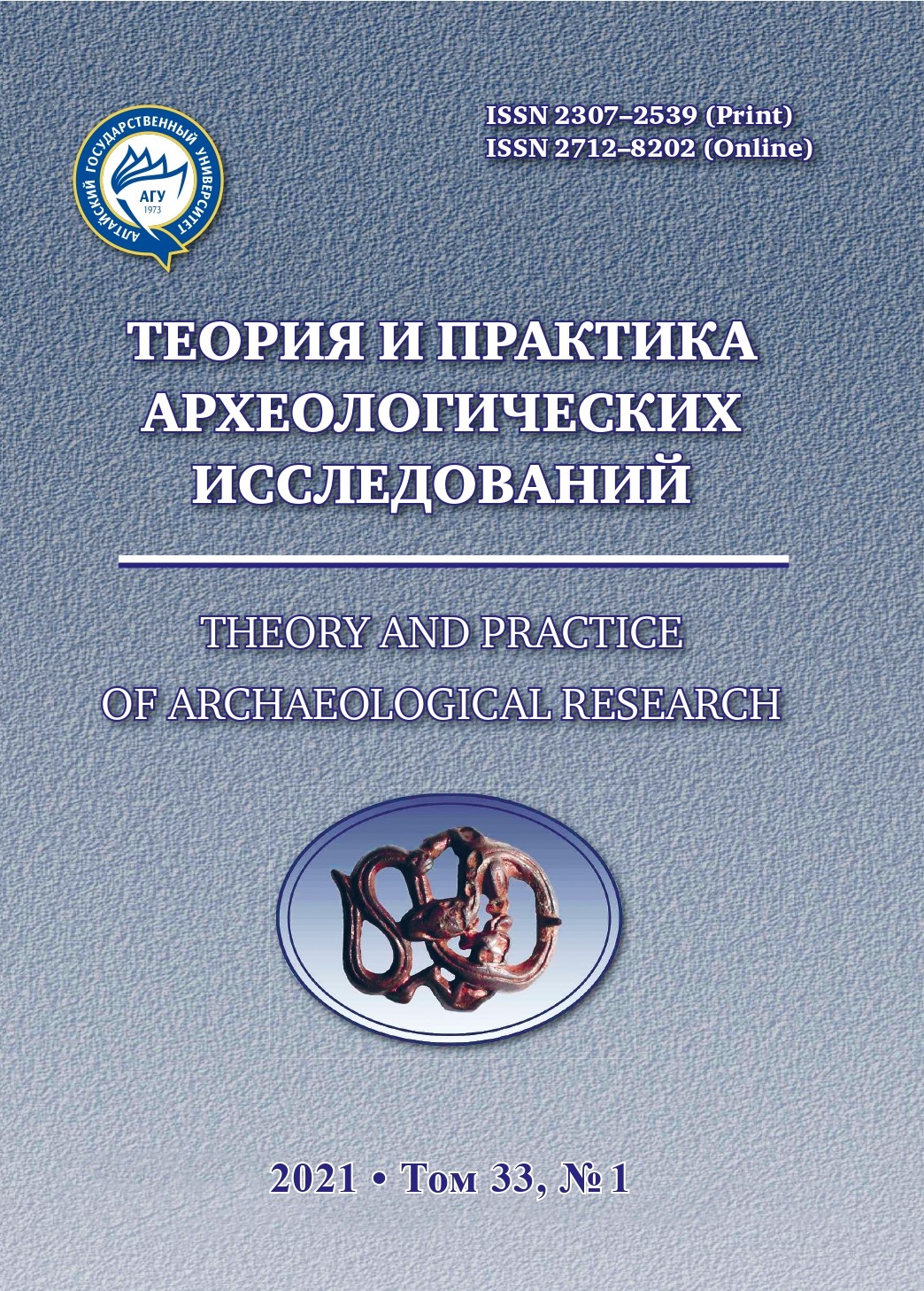RESULTS OF GEOPHYSICAL RESEARCH AT THE UST’-BIYKE-I SITE (IN ALTAI)
DOI:
https://doi.org/10.14258/tpai(2021)33(1).-05Keywords:
Altai, archaeological site, geophysical research, electrical resistivity tomography, groundpenetrating radar, settlemenAbstract
Ust’-Biyke-I may become one of the most important archaeological complexes in the northern Altai region. Previous research established that the site was first occupied in the developed Mesolithic. Traces of subsequent occupations up to the Bronze Age were later discovered, in addition to burial structures. A loss of archaeological deposits at the mouth of the Biyke River occurred due to natural and anthropogenic activity. In order to identify the most promising areas for future excavations, geophysical surveys of the site were conducted. An area of 31.5 x 24 m was examined with electrical resistivity tomography (ERT) and ground-penetrating radar (GPR). Results revealed an object with a diameter of about 4 m that was not visible on the ground surface. In its center at a depth of 1.5 m, a local anomaly was observed. Another isometric anomaly was observed in the southwestern part at a depth of 0.75 m. Other anomalies were also noted in the surveyed area, some of which are visible in the modern terrain as small depressions. Future excavations will clarify the geophysical survey.
Downloads
References
Kungurov A.L., Tishkin A.A. Nahodki final’nogo mezolita v ust’e r. Bijke (Gornyj Altaj) [Finds of the Final Mesolithic at the Mouth of the Biike River (Gorny Altai)]. Ohrana i izuchenie kul’turnogo naslediya Altaya [Protection and Study of the Cultural Heritage of Altai]. Barnaul: Izd-vo Alt. un-ta, 1993. Vol. 1. Pp. 46–51. (In Russ.)
Semibratov V.P., Majchikov O.V. Poselenie Ust’-Bijke-I. Itogi i perspektivy izucheniya [The Ust-Biyke-I Settlement. Results and Perspectives of the Study]. Sohranenie i izuchenie kul’turnogo naslediya Altajskogo kraya [Preservation and Study of the Cultural Heritage of the Altai Territory]. Barnaul : Izd-vo Alt. un-ta, 1997. Issue VIII. Pp. 108–113. (In Russ.)
Tishkin A.A., Gorbunov V.V. Kompleks arheologicheskih pamyatnikov v doline r. Bijke (Gornyj Altaj) [A Complex of Archaeological Sites in the Valley of the Biike river (the Altai Mountains)]. Barnaul : Izd-vo Alt. un-ta, 2005. 200 p. (In Russ.)
Lanzarone P., Seidel M., Brandt S., Garrison E., Fisher E. C. Ground-Penetrating Radar and Electrical Resistivity Tomography Reveal a Deep Stratigraphic Sequence at Mochena Borago Rockshelter, southwestern Ethiopia. Journal of Archaeological Science: Reports. Vol. 26 (2019). P. 101915. (In Eng.) DOI: 10.1016/j.jasrep.2019.101915
Malfitana D., Giovanni L., Giovanni F., Nicola M., Giuseppe S., Giuseppe C., Cettina S., Eduard Sh. The Potential of Integrated GPR Survey and Aerial Photographic Analysis of Historic Urban Areas: A Case Study and Digital Reconstruction of a Late Roman villa in Durrës (Albania). Journal of Archaeological Science: Reports. 2015. Vol. 4. P. 276–284. (In Eng.) DOI: 10.1016/j.jasrep.2015.09.018
Orlando L. GPR to Constrain ERT Data Inversion in Cavity Searching: Theoretical and Practical Applications in Archaeology. Journal of Applied Geophysics. 2013. Vol. 89. Pp. 35–47. (In Eng.)
Osipova E., Danukalova G., Brancaleoni G., Krajcarz M., Abdykanova A., Shnaider S. Palaeoenvironmental Conditions of the Palaeolithic — Neolithic Transition in the Fergana Valley (Central Asia) — New Data Inferred from Fossil Mollusсs in Obishir-V Rockshelter (Kyrgyzstan). Quaternary International. In print. (In Eng.) DOI: 10.1016/j.quaint.2020.11.009


